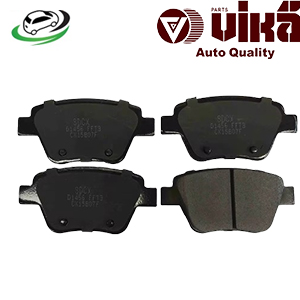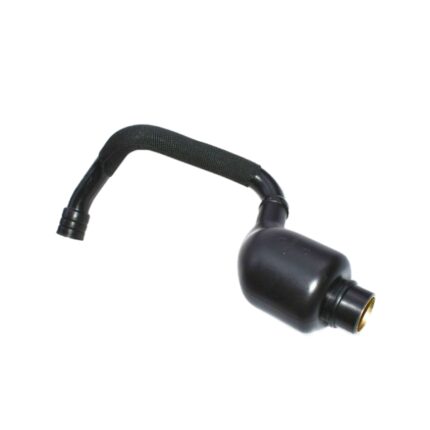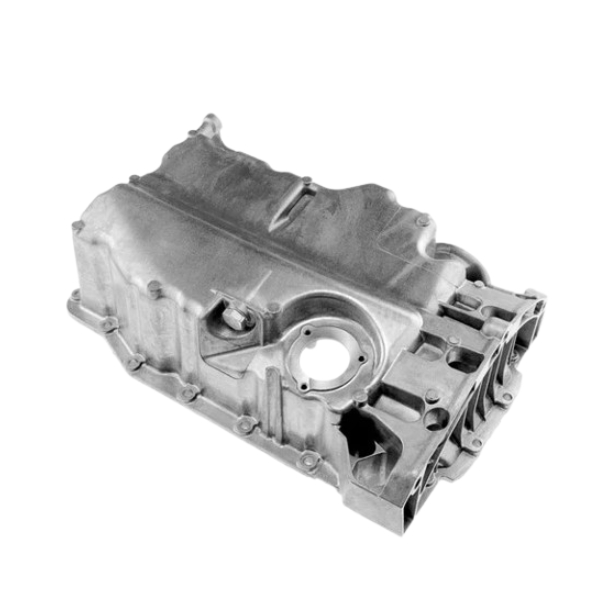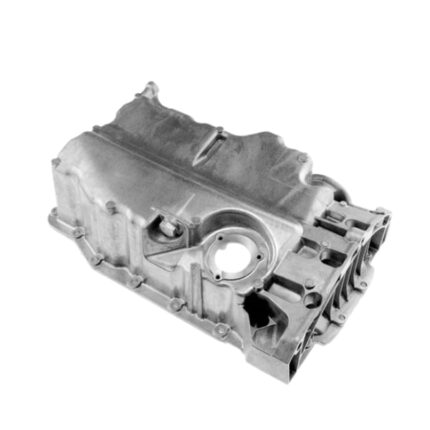Get AUDI A3 Wet Sump Oil Sump 04E103601G in Kenya
The oil sump, often referred to as the oil pan, is a vital component of an internal combustion engine’s lubrication system. It serves as a reservoir for engine oil, housing the oil that lubricates and cools the engine’s moving parts. The oil sump plays a crucial role in maintaining engine performance and longevity, and understanding its design, function, types, materials, potential issues, and maintenance is essential for anyone involved in automotive repair or engineering.
Function of the Oil Sump
The primary function of the oil sump is to store engine oil. This oil is essential for lubricating the engine’s moving parts, such as the crankshaft, camshaft, pistons, and valves, reducing friction and preventing excessive wear. Additionally, engine oil helps to cool these components by dissipating heat generated during engine operation.
The oil sump also plays a role in oil circulation. Oil is pumped from the sump by the oil pump through various passages and galleries in the engine to reach all critical components. After lubricating and cooling these parts, the oil returns to the sump to be recirculated. The oil sump’s design ensures that there is always a sufficient supply of oil available for the engine, even during rapid acceleration, hard braking, or cornering, which could cause the oil to slosh around within the sump.
Design and Components of an Oil Sump
The oil sump is a relatively simple component, but its design is critical to the overall efficiency and performance of the engine’s lubrication system. Key aspects of the oil sump include:
- Shape and Size: The shape and size of the oil sump are designed to maximize the amount of oil that can be stored while fitting within the engine’s constraints. Most oil sumps are designed with a deeper section at the bottom, known as the sump well, where the oil is collected and where the oil pickup tube is located.
- Oil Pickup Tube: This tube extends from the oil pump down into the sump well. It’s responsible for drawing oil from the sump and delivering it to the pump, which then circulates the oil throughout the engine. The positioning of the pickup tube is crucial to ensure a constant oil supply, even when the vehicle is on an incline or in motion.
- Baffles: Many oil sumps are equipped with baffles, which are metal plates or barriers inside the sump. Baffles help control the movement of oil within the sump, preventing it from sloshing around too much during sharp turns or sudden stops. This ensures that the oil pickup tube remains submerged in oil, preventing oil starvation.
- Drain Plug: The oil sump features a drain plug, typically located at the lowest point of the sump. This plug is removed during an oil change to allow the old oil to drain out of the engine. The plug is usually magnetic to capture any metal particles that might be present in the oil, which could indicate wear on engine components.
- Gasket: The oil sump is sealed to the bottom of the engine block using a gasket. This gasket is critical to preventing oil leaks at the joint between the sump and the engine block. Over time, gaskets can degrade and need to be replaced to maintain a proper seal.
Types of Oil Sumps
Oil sumps come in various designs, each suited to different types of engines and vehicles:
- Wet Sump: The most common type of oil sump found in most passenger vehicles is the wet sump. In this design, the oil is stored in the sump at the bottom of the engine, and the oil pump draws directly from it. Wet sumps are simple, cost-effective, and easy to maintain, making them ideal for everyday vehicles.
- Dry Sump: Dry sump systems are typically used in high-performance or racing vehicles. In a dry sump system, the oil is stored in an external reservoir rather than in the sump itself. A series of pumps circulate the oil from the reservoir to the engine and back. This design allows for greater oil capacity, better oil cooling, and more consistent oil pressure under extreme conditions. Additionally, dry sumps enable a lower engine profile, which can improve aerodynamics and lower the vehicle’s center of gravity.
- Integrated Sump: In some modern engines, the oil sump is integrated into the engine’s design, serving as a structural component that contributes to the engine’s overall rigidity. These sumps may also incorporate features like oil coolers or advanced baffling systems to enhance performance.
- Deep Sump: Deep sumps are typically aftermarket components used in high-performance applications. They are designed to hold more oil than standard sumps, which can improve cooling and lubrication in demanding conditions. Deep sumps are often equipped with additional baffles or trap doors to ensure consistent oil delivery to the pickup tube.
Common Issues with Oil Sumps
Despite their simplicity, oil sumps can encounter several issues that may require attention:
- Oil Leaks: One of the most common issues with oil sumps is leaking oil, usually due to a degraded or damaged gasket. If the gasket between the sump and the engine block fails, oil can seep out, leading to low oil levels and potential engine damage. Regular inspection and timely gasket replacement can prevent this issue.
- Damaged Sump: The oil sump is located at the bottom of the engine, making it vulnerable to damage from road debris, speed bumps, or rough terrain. A cracked or punctured sump can result in oil loss and engine failure if not addressed promptly. Drivers who frequently encounter rough driving conditions may consider installing a sump guard to protect the sump from damage.
- Clogged Oil Pickup: If debris or sludge accumulates in the sump, it can clog the oil pickup tube, leading to reduced oil flow to the engine. This can cause oil starvation, which can severely damage the engine. Regular oil changes and using high-quality oil can help prevent sludge buildup.
- Corrosion: Over time, the metal components of the oil sump can corrode, especially in vehicles driven in harsh environments or areas with road salt. Corrosion can weaken the sump and lead to oil leaks. Regular inspections and, if necessary, applying protective coatings can help mitigate corrosion.
Signs of worn out Oil Sumps
1. Oil Leaks
Description
One of the most apparent signs of a worn-out oil sump is the presence of oil leaks. These leaks can manifest as oil spots or puddles under the vehicle, particularly after it has been parked for some time.
Causes
- Damaged Gasket: The oil sump is sealed to the bottom of the engine block using a gasket. Over time, this gasket can deteriorate due to heat exposure, age, and constant contact with oil, leading to leaks.
- Cracks or Holes: Physical damage to the oil sump, such as cracks or holes caused by impacts from road debris, speed bumps, or off-road driving, can result in oil seeping out.
- Loose or Damaged Drain Plug: The drain plug at the bottom of the oil sump may become loose or damaged, especially after frequent oil changes, leading to leaks.
- Corrosion: Prolonged exposure to moisture, road salt, and other corrosive elements can cause the metal of the oil sump to rust and develop leaks.
Identification
- Visual Inspection: Check under the vehicle for any signs of oil dripping or pooling. Inspect the oil sump and surrounding areas for wetness or oil stains.
- Oil Level Monitoring: Regularly check the engine oil level using the dipstick. A consistently decreasing oil level without apparent consumption indicates a leak.
- Warning Lights: The oil pressure warning light on the dashboard may illuminate if there’s a significant oil leak leading to low oil levels.
Consequences
Ignoring oil leaks can lead to low oil levels, resulting in inadequate lubrication and cooling of engine components. This can cause increased friction, overheating, and ultimately severe engine damage or failure.
2. Visible Damage or Deformation
Description
Physical damage to the oil sump, such as dents, cracks, or deformations, is a clear sign of a worn-out or compromised component.
Causes
- Impact Damage: Hitting speed bumps, curbs, rocks, or debris can dent or crack the oil sump, especially in vehicles with low ground clearance.
- Manufacturing Defects: Although rare, defects in the manufacturing process can result in weak spots that may fail over time.
- Corrosion and Rust: Extended exposure to moisture and road salt can cause the oil sump to corrode and weaken, making it more susceptible to damage.
Identification
- Under-Vehicle Inspection: Visually inspect the oil sump for any signs of dents, cracks, or deformities. Use a flashlight to check hard-to-see areas.
- Oil Stains Around Damage: Look for oil stains or wetness around any visible damage, indicating that oil is seeping through cracks or holes.
- Unusual Engine Behavior: Physical damage may restrict oil flow, leading to unusual engine noises or performance issues.
Consequences
A damaged or deformed oil sump can impede the proper circulation of oil, leading to inadequate lubrication and cooling. Severe damage may result in rapid oil loss and immediate engine failure.
3. Low Oil Pressure
Description
A decrease in oil pressure is a significant indicator of potential problems with the oil sump or the lubrication system in general.
Causes
- Oil Leaks: As previously mentioned, leaks from a damaged oil sump reduce the overall oil volume, leading to decreased oil pressure.
- Clogged Oil Pickup Tube: Debris or sludge accumulation in the oil sump can clog the oil pickup tube, restricting oil flow and reducing pressure.
- Oil Pump Issues: While not directly related to the oil sump, problems with the oil pump can also cause low oil pressure, which may be exacerbated by issues within the sump.
Identification
- Dashboard Warning Light: Most vehicles have an oil pressure warning light that illuminates when the pressure drops below a safe level.
- Oil Pressure Gauge: Vehicles equipped with an oil pressure gauge will show a lower than normal reading.
- Engine Performance: Symptoms such as engine knocking, ticking noises, or reduced performance may accompany low oil pressure.
Consequences
Persistently low oil pressure can cause severe engine damage due to insufficient lubrication. Critical engine components may wear out rapidly, leading to costly repairs or complete engine failure.
4. Unusual Engine Noises
Description
Strange noises emanating from the engine compartment can be a symptom of oil sump issues affecting the engine’s lubrication system.
Causes
- Oil Starvation: A damaged or leaking oil sump can lead to low oil levels, causing metal-to-metal contact between engine parts and resulting in knocking or ticking noises.
- Air Entrapment: If the oil sump is damaged or the oil level is too low, air can enter the oil pump, causing cavitation and producing a whining or rattling sound.
- Sludge Buildup: Accumulation of sludge in the oil sump can restrict oil flow, leading to increased friction and unusual noises from the engine.
Identification
- Knocking or Tapping Sounds: These noises typically indicate that the engine’s moving parts are not receiving adequate lubrication.
- Whining or Rattling Noises: Such sounds may suggest air in the oil system or issues with the oil pump caused by problems in the oil sump.
- Noise During Startup: If unusual noises are more pronounced during engine startup, it could indicate that oil is not reaching vital components promptly due to issues with the sump.
Consequences
Ignoring unusual engine noises can lead to extensive damage as components continue to operate without proper lubrication. This can result in accelerated wear and eventual failure of engine parts like bearings, camshafts, and pistons.
5. Overheating Engine
Description
The engine overheating is a serious issue that can sometimes be linked to problems with the oil sump and the engine’s lubrication system.
Causes
- Insufficient Oil Levels: Leaks from a damaged oil sump reduce oil levels, diminishing the oil’s ability to absorb and dissipate heat.
- Restricted Oil Flow: Debris or sludge in the oil sump can impede oil circulation, causing increased friction and heat generation.
- Oil Contamination: A compromised oil sump may allow contaminants to enter the oil, reducing its effectiveness in cooling the engine.
Identification
- Temperature Gauge: The engine temperature gauge on the dashboard will indicate higher than normal readings.
- Warning Lights: The engine temperature warning light may illuminate, signaling overheating.
- Steam or Smoke: Visible steam from the engine compartment or unusual smoke from the exhaust can indicate overheating.
- Reduced Performance: The engine may experience power loss or stalling due to excessive heat.
Consequences
Continued operation of an overheating engine can cause severe damage, including warped cylinders, blown head gaskets, and cracked engine blocks. Immediate attention is required to prevent catastrophic engine failure.
6. Presence of Metal Shavings in Oil
Description
Finding metal particles or shavings in the engine oil is a concerning sign that may be associated with oil sump problems.
Causes
- Internal Engine Wear: Inadequate lubrication due to oil sump issues can cause excessive wear on engine components, leading to metal particles entering the oil.
- Damaged Oil Sump: A compromised sump may fail to trap and filter out metal debris effectively, allowing it to circulate with the oil.
- Defective Drain Plug Magnet: Many oil sump drain plugs have magnets to collect metal particles. If damaged or missing, metal shavings remain suspended in the oil.
Identification
- Oil Change Inspection: During an oil change, inspect the drained oil for metallic particles or a glittery appearance.
- Oil Filter Examination: Check the oil filter for metal shavings, which indicate internal engine wear.
- Unusual Engine Sounds: The presence of metal in the oil may coincide with knocking or grinding noises from the engine.
Follow us on Facebook for more parts.




